- Car finance Car finance
- Motorbike finance Motorbike finance
- Van finance Van finance
- How it works How it works
- FAQs and guides FAQs and guides
- About us About us
- Start a new quote
- Home
- Blog
- Latest Motor News
- Car Crime Hotspots
Car Crime Hotspots
Updated: Friday, 11 October 2024
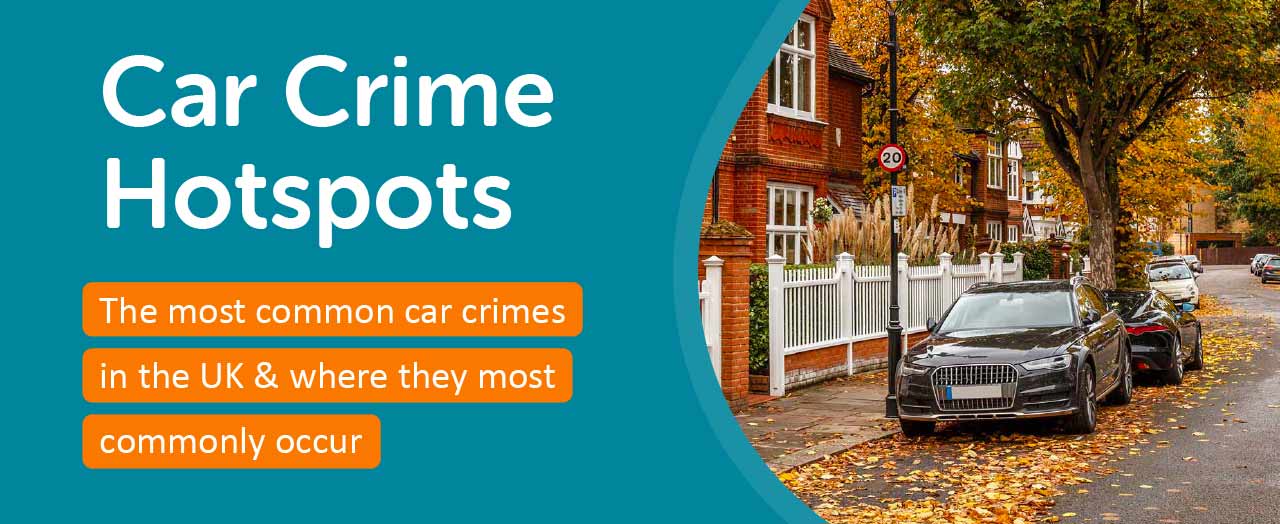
The most common car crimes in the UK & where they most commonly occur.
Owning a car, while liberating, can be stressful and sometimes costly. There’s a need for you to keep on top of your car finance payments, maintenance and repairs, the increasing costs of fuel, and adhering to the many laws of the road. If that wasn’t enough, there is also the risk that criminals may target your car.
The countless laws of the road, such as the legal obligation for your car to have seatbelts and for everyone inside the vehicle to be wearing one, are in place to better protect road users and even pedestrians. While the cost of maintaining your vehicle and keeping up with finance payments and insurance may be a financial burden to many, those things are necessary to keep you and others safe on the road.
Despite these being legal obligations, many using the roads do not observe these laws. Unfortunately, if you do adhere to the laws of the road, that doesn’t stop criminals from potentially targeting your vehicle. Whether that be damaging your car and stealing possessions within it, or even stealing the car in its entirety.
With so many laws being involved in owning a car, we’ve taken a look at a range of UK government data from 2022 to determine which car-related crimes are the most common and which areas of the UK these crimes are most commonly committed.
We have compared this to 2021 data to provide insight into how things have changed over the last couple of years.
The most common car crimes in the UK
Below, we have the most common car crimes that occur in the UK. Combining the number of occurrences for each crime by region, we have the national totals and have ranked them from most to least commonly occurring.

1. Speed limit offences: 2,854,757
The most common, and least surprising, car crime in the UK is speed limit offences. Recorded as the most common car crime in 2021, in 2022 the annual national total was up to more than 2.8 million. This is an increase of around one million from 2021. As ever, these speed limits should not be disregarded as they are in place to ensure everyone is travelling at a safe speed for each road in the country.
2. Theft from vehicle: 199,432
Thefts from vehicles are the second most committed car crime in the UK. For 2021-22, there were 199,432 thefts from vehicles, an increase of around 7,000 since 2021. This serves as a reminder to keep your car locked and remove any valuables so that it’s not a target for thieves.
3. Criminal damage to a vehicle: 169,797
The UK’s third most common car crime is criminal damage to a vehicle, also taking third place in 2021. The number of occurrences of this crime increased by more than 10,000 in 2022. This crime is summarised as damage consciously inflicted upon someone else’s vehicle, which can happen during a heated disagreement or even if someone hits your car with theirs and simply drives off; even if accidental, this is considered to be vandalism.
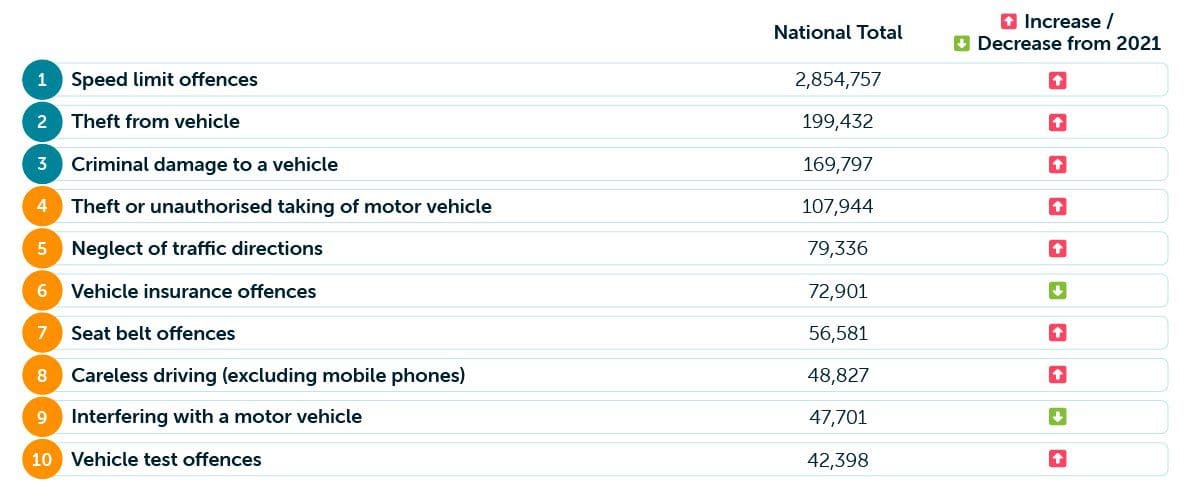
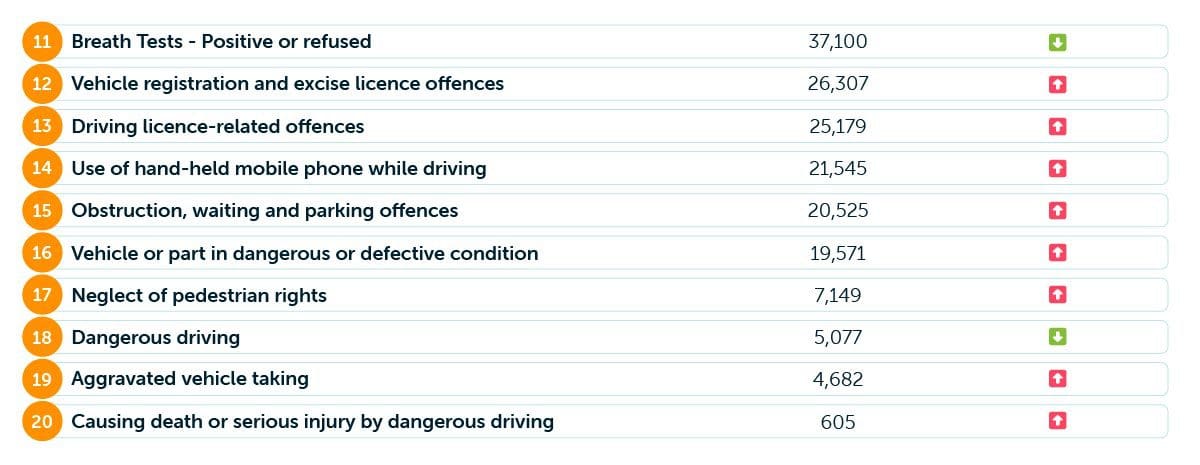
The parts of the country where each car crime is most common
With the most common car crimes in the country revealed, we now look at the car crime hotspots in the UK.

Speed limit offences
We have already established that speed limit laws are in place to better protect users of the road and pedestrians too. These speed limits are in place to ensure that everyone travels at a safe speed to reduce the risk of road collisions involving other drivers, or pedestrians.
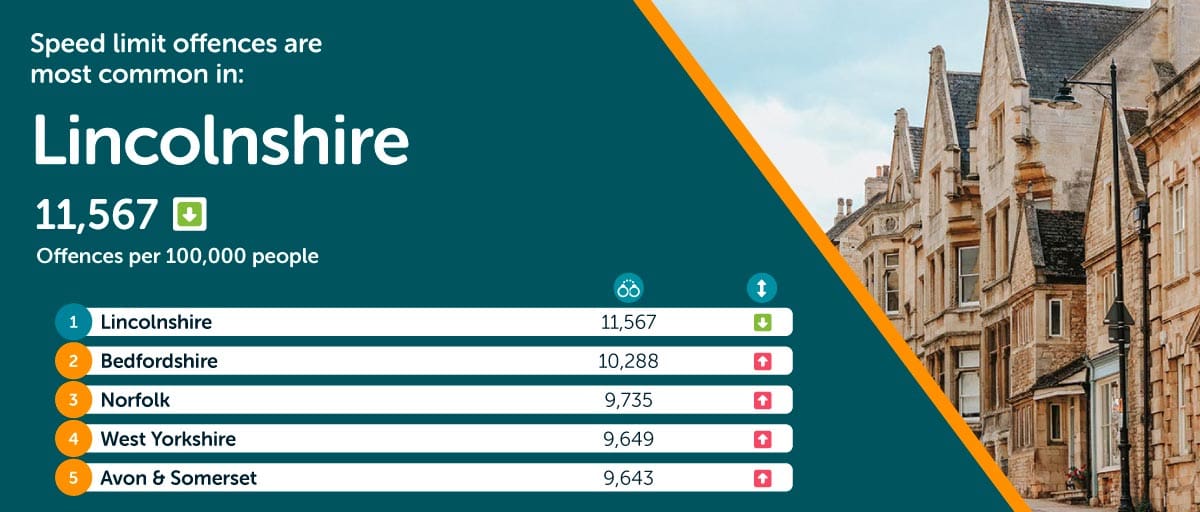
Lincolnshire, offences per 100,000 people: 11,567
Lincolnshire is the UK’s speeding hotspot, with 11,567 instances of speeding offences, per 100,000 people in 2022. This is a 14% decrease since 2021, which was 13,420 per 100,000 people, but still lands the city in the top spot.
Theft from vehicle
Anyone can find themselves a victim of this crime, that’s why it’s best to keep your car locked at all times, with any valuables removed, and if possible in a well-lit place with CCTV.
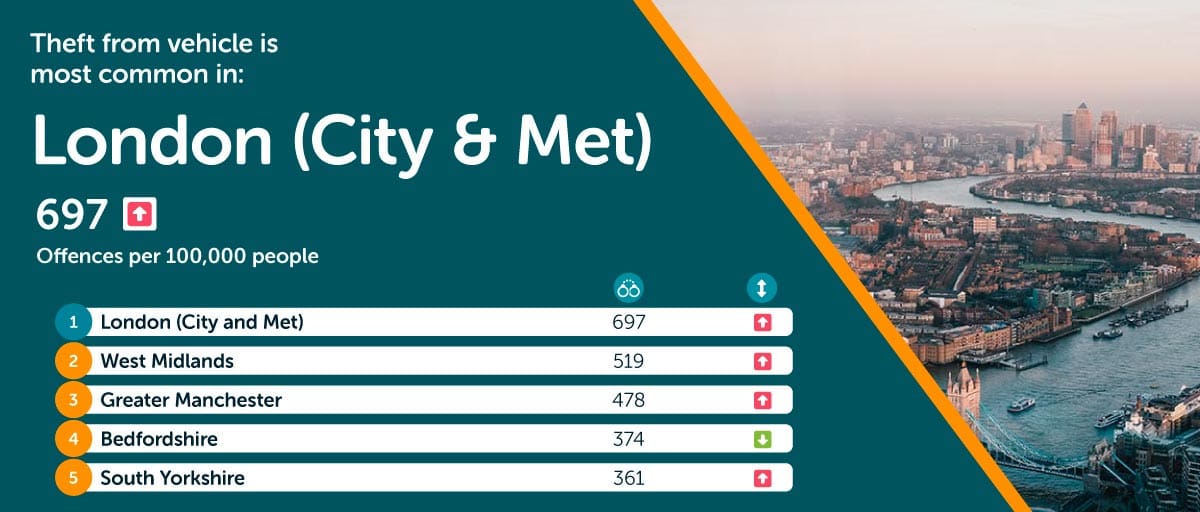
London (City & Met), offences per 100,000 people: 697
London has the most theft from vehicle offences in the UK, with 697 per 100,000 people, a marginally higher rate than the 688 per 100,000 people in 2021. The West Midlands takes second place, with the region having 519 offences per 100,000 people, a sharp rise from 208 per 100,000 in 2021.
Criminal damage to a vehicle
One of the most frustrating car crimes is being targeted by someone who deliberately damages your vehicle for seemingly no good reason.
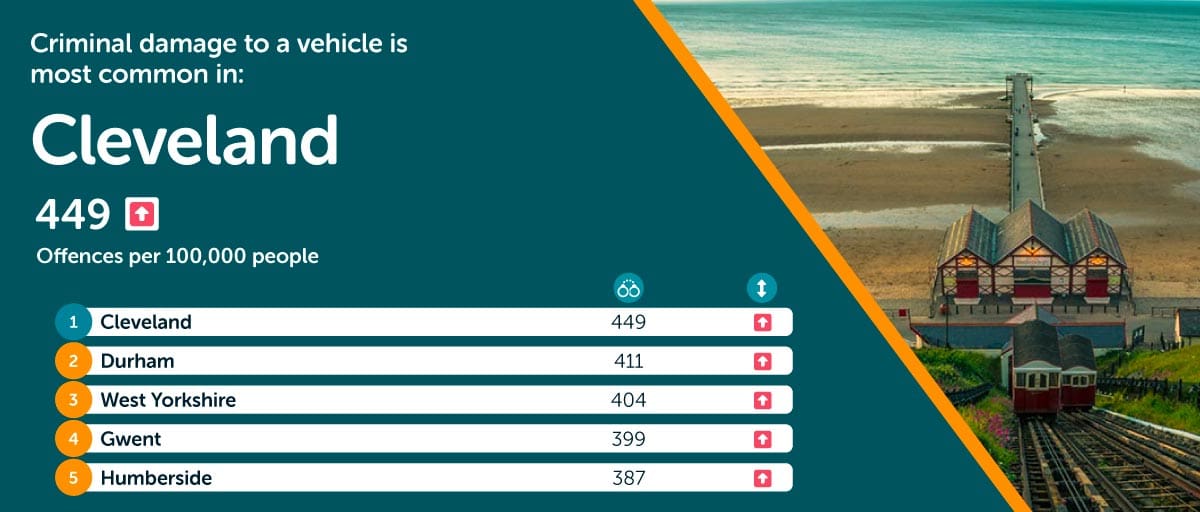
Cleveland, offences per 100,000 people: 449
Taking the top spot is the historic county of Cleveland, located in the North East of England, with the highest rates of criminal damage to vehicles. They recorded 449 offences per 100,000 people, which is a slight increase from 2021’s 430 per 100,000 people.
Theft or unauthorised taking of a motor vehicle
Just as having your car damaged can be a stressful experience, having your entire vehicle stolen can leave the owner of the car distraught and deeply inconvenienced. While insurance may cover this crime, this does not lessen the emotional and financial impact it can have.
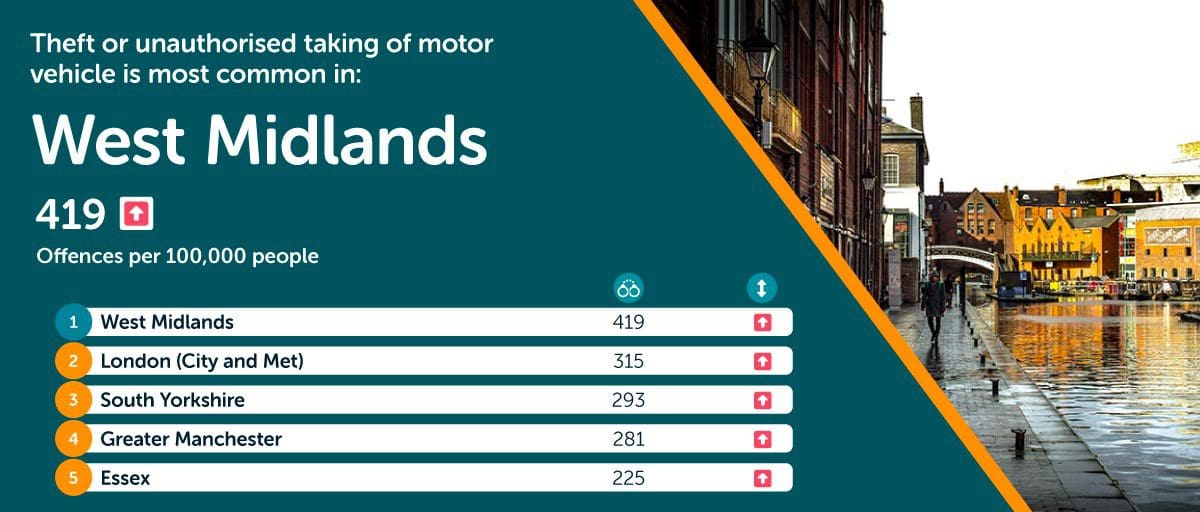
West Midlands, offences per 100,000 people: 419
West Midlands comes out as the area with the most car theft offences in the UK, with 419 per 100,000 people. In 2021, London placed first with 278 car thefts per 100,000, so this is quite the increase.
Neglect of traffic directions
Traffic directions can take many forms, from road signs to traffic lights, and should not be taken lightly or ignored. They are in place to ensure that traffic runs smoothly and to also guide pedestrians as they navigate crossings. Neglecting these directions can put you, other road users and pedestrians in severe danger.
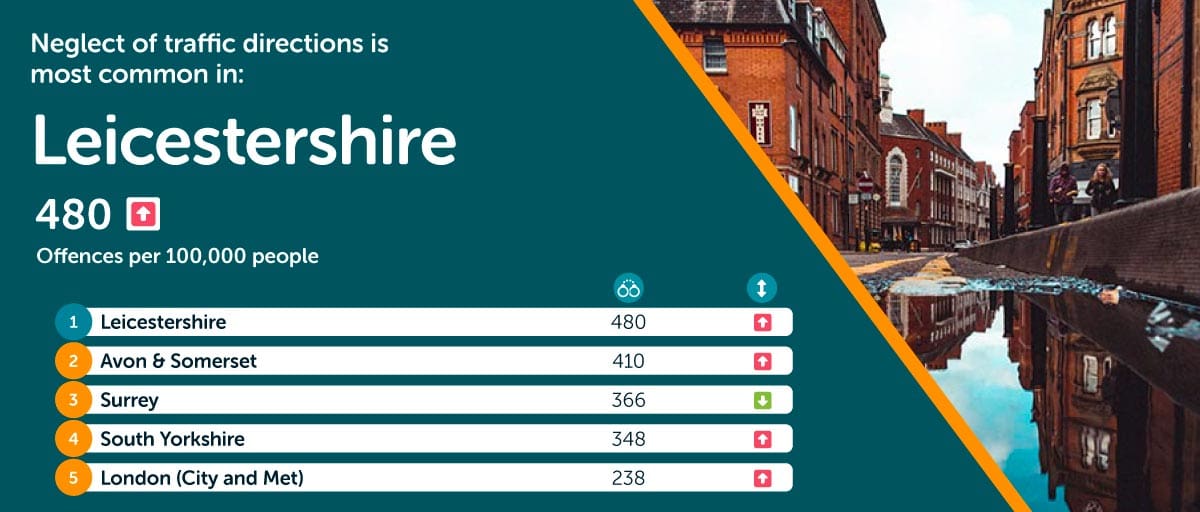
Leicestershire, offences per 100,000 people: 480
Leicestershire has the most neglect of traffic directions offences, registering 480 instances of this particular offence, per 100,000 people. In 2021, Surrey had the most offences of this kind, with 416.
Vehicle insurance offences
All vehicles on the road are legally required to have insurance, this serves to protect yourself and other road users in the event of an accident. Driving without any insurance will result in a £300 fine and up to six points on your licence. Though in the event this goes to court, you could get an unlimited fine and be disqualified from driving.
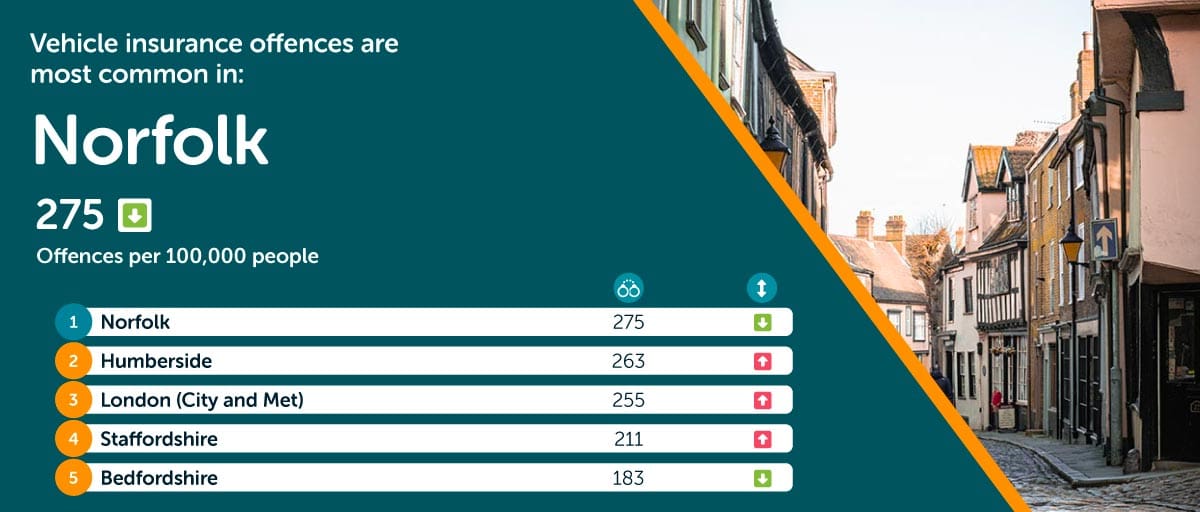
Norfolk, offences per 100,000 people: 275
With 275 vehicle insurance offences per 100,000 people, Norfolk takes the number one spot. However, the number of offences has decreased somewhat, as previously Norfolk recorded 292 offences per 100,000 people in 2021.
Seat belt offences
Seat belts have been a legal requirement since 1983 in the UK and have undoubtedly been responsible for saving countless lives. Despite this, it is the seventh most common car crime in the UK. If you are caught not wearing a seatbelt when you should be, you could face a fine of up to £500.
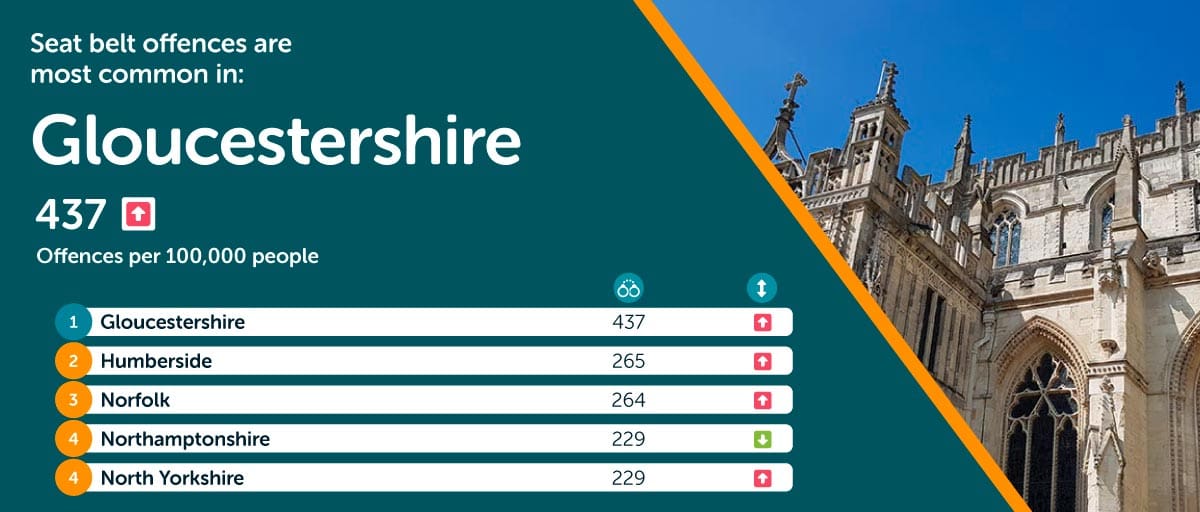
Gloucestershire, offences per 100,000 people: 437
Gloucestershire registered 437 seat belt offences per 100,000 people in 2022, making it the most offending area in the UK for this specific crime! In second place, Humberside also registered 265 per 100,000 people. The top six ranking areas in the UK for this offence all registered more than 200 offences per 100,000.
Careless driving (excluding mobile phones)
This is when the person in charge of a vehicle does so without the proper care and attention required. This can endanger other road users, the fixed penalty for this offence is a £100 fine and three points on your licence.
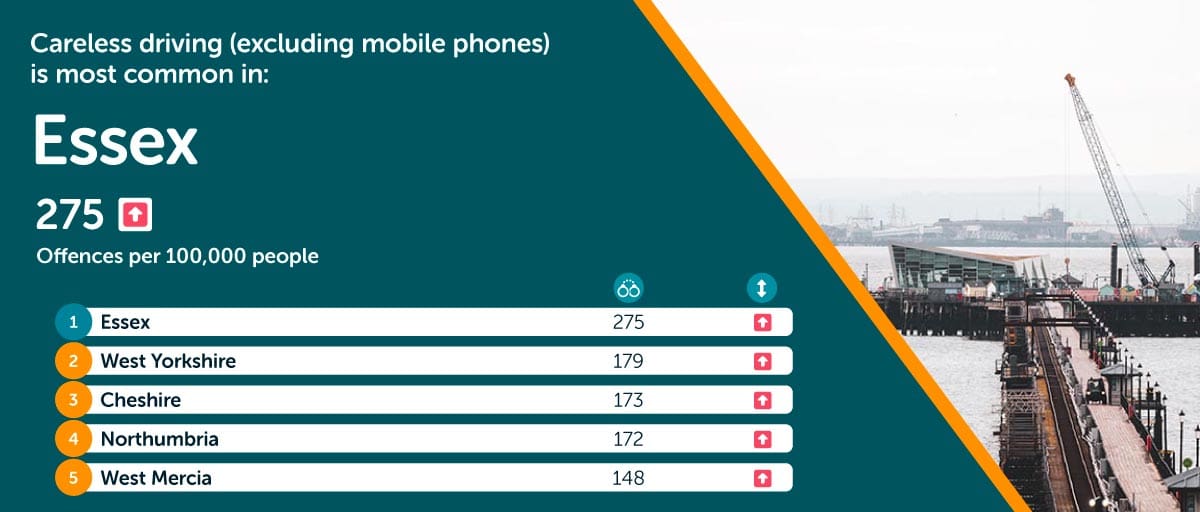
Essex, offences per 100,000 people: 275
Essex by far has the most careless driving offences (where mobile phones are not concerned) with 275 per 100,000 people in 2022. Every other area in the UK managed below 200.
Interfering with a motor vehicle
Interfering with a motor vehicle refers to someone tampering with a car, internal and external car parts, or the contents of a car. This offence can result in a prison sentence of up to three months.
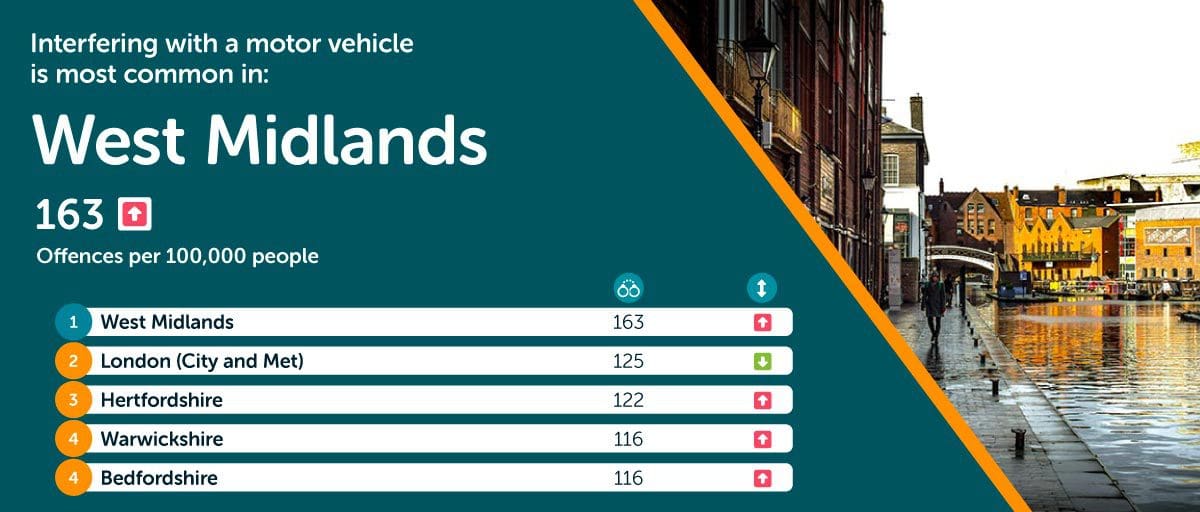
West Midlands, offences per 100,000 people: 163
The West Midlands recorded 163 instances of this crime per 100,000 people, making it the number one offender of this crime. There is quite a gap between second-placed London, who recorded just 125 per 100,000 people.
MOT offences
With the use of your vehicle comes the inevitable wear and tear of its components, leading to faults that can potentially put yourself and other road users at risk. However, this is where MOT tests come in, as every vehicle is required to have one annually, to make sure your vehicle is road safe. Driving without having passed an MOT test is an offence.
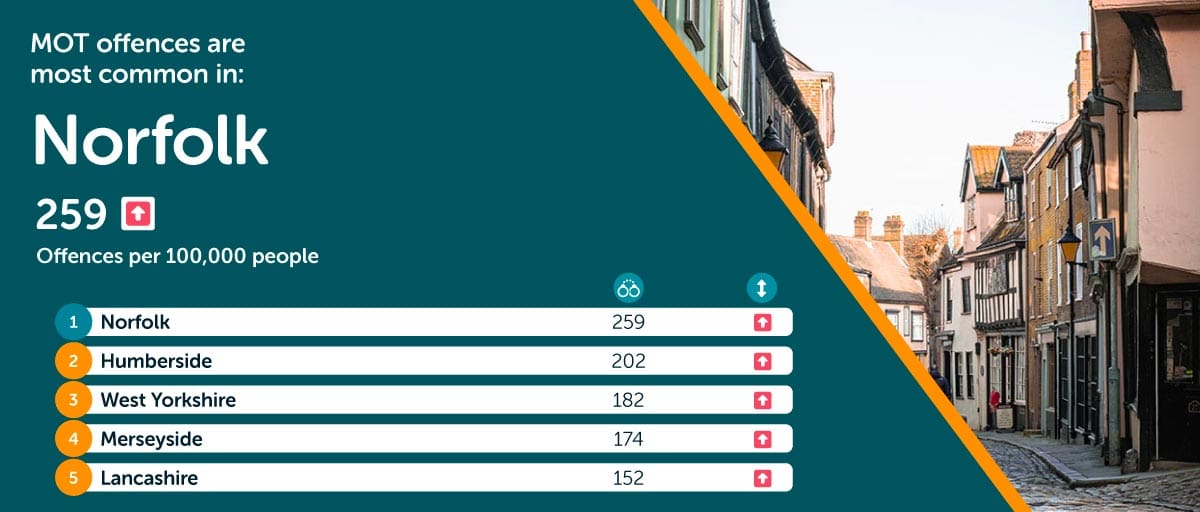
Norfolk, offences per 100,000 people: 259
Norfolk takes first place for the most MOT offences per 100,000 people in the UK, with 259, an increase of around 100 compared to 2021’s numbers. In second place was Humberside with 202, which is also quite a gap.
Breath Tests - Positive or refused
Driving under the influence of substances such as drugs and alcohol is against the law, as it is extremely dangerous and can put road users at serious risk. Breath tests are the main way of catching culprits, a positive test or refusal of the test being indicative of a crime being committed.
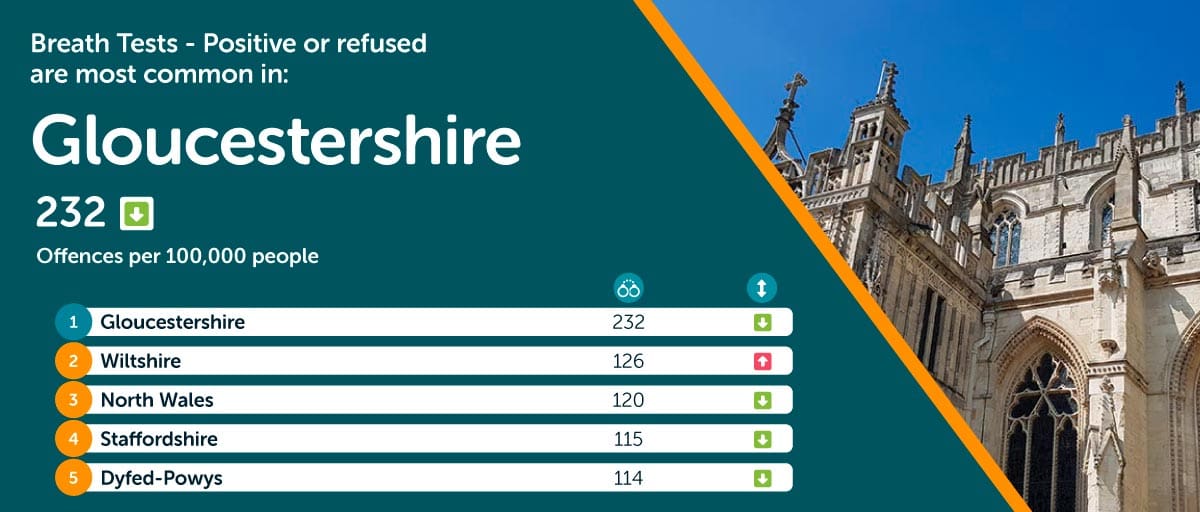
Gloucestershire, offences per 100,000 people: 232
With 232 instances per 100,000 people of breath tests coming back positive or refused, Gloucestershire is the number one offender of this particular crime. In 2021, Gloucestershire also ranked first, however, their figure was much higher at 303 per 100,000.
Vehicle registration and excise licence offences
Vehicles driven on public roads must be registered and taxed. Road tax helps to pay for the upkeep and maintenance of the UK’s road network, making them safer to use.
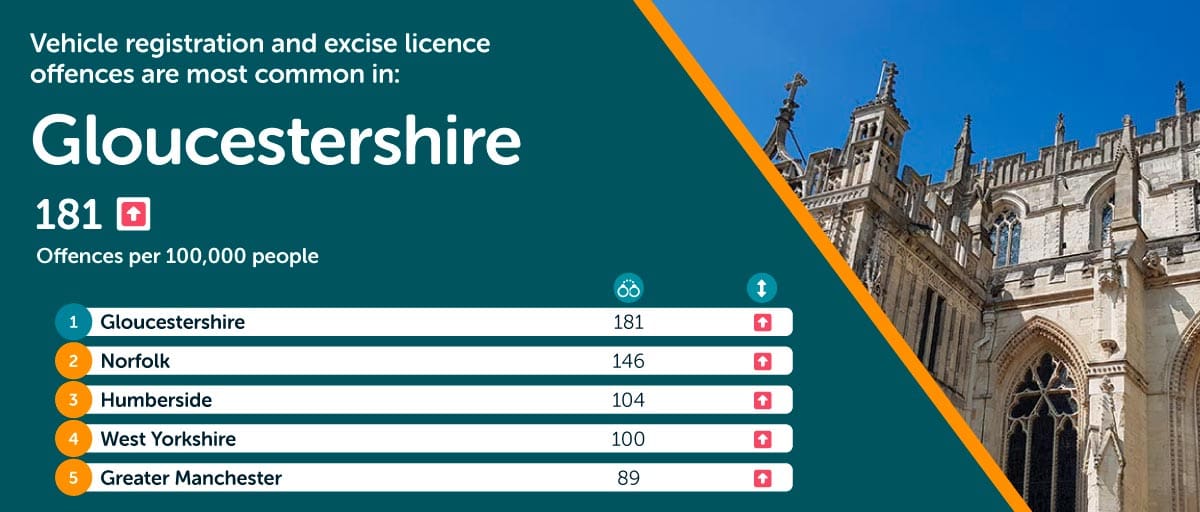
Gloucestershire, offences per 100,000 people: 181
Gloucestershire once again tops the rankings, this time for vehicle registration and excise licence offences, with 181 occurrences of this offence per 100,000 people. Only Norfolk and Humberside, alongside Gloucestershire, managed more than 100 occurrences of this offence in the UK per 100,000 people.
Driving licence-related offences
Every driver in the UK is legally required to have a driver’s licence, this serves as proof that you are a competent driver who can observe all the laws of the road. Learners can drive using a provisional driving licence, but only so long as they are accompanied by another individual who has had their full driving licence for several years. Driving without a licence is a severe offence, and if caught, can get you up to six penalty points and a fine of up to £5,000.
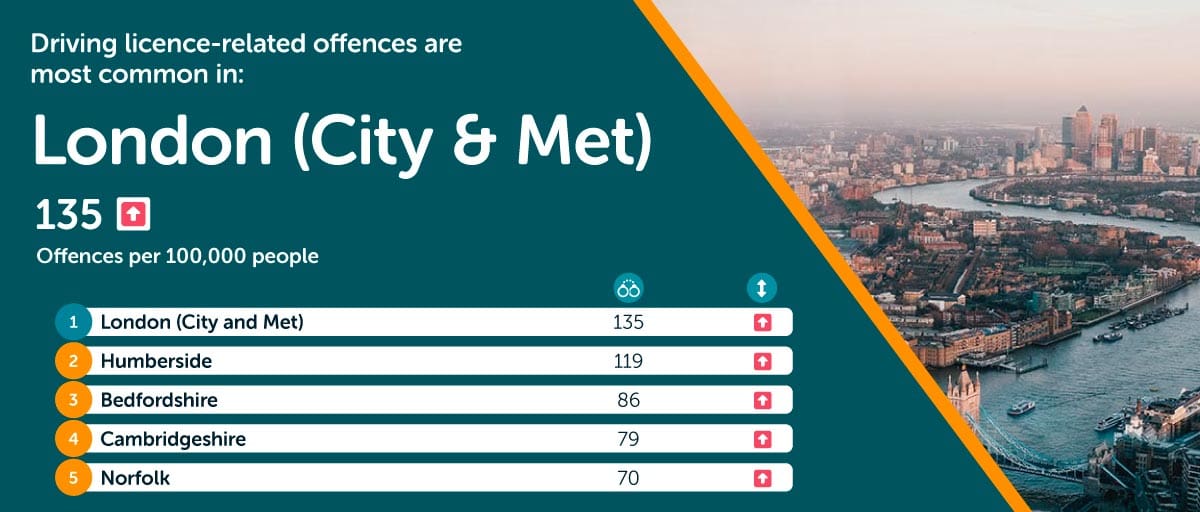
London, offences per 100,000 people: 135
England’s capital city has the highest rate of driving licence-related offences in the UK, with 135 per 100,000 people. Narrowly in second place, we have Humberside, with 119, making these two areas the only ones in the UK with more than 100 offences for this crime per 100,000 people.
Use of hand-held mobile phone while driving
Using a hand-held mobile phone whilst driving can distract the driver’s attention from the road, potentially putting other road users at risk of serious injury or worse. As such, it is illegal to do so in the UK and can result in six points on your licence and a £200 fine. If you passed your driving test within two years of being caught doing so, your licence can be revoked.
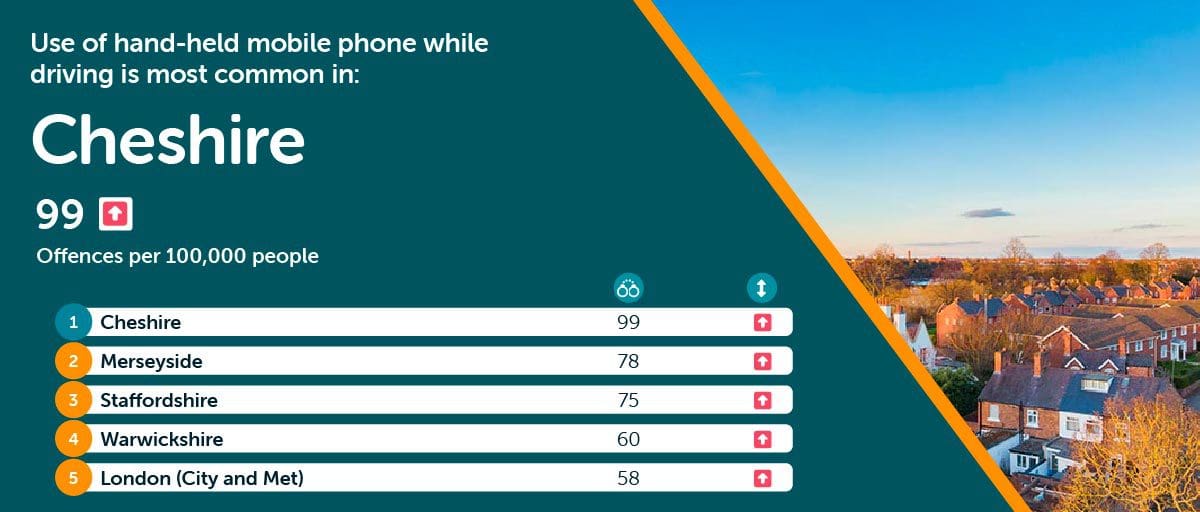
Cheshire, offences per 100,000 people: 99
With 99 occurrences per 100,000 of the area’s population, Cheshire has the highest rate of people being caught using hand-held mobile phones while driving. Every area in the UK had below 100 occurrences of this offence per 100,000 people.
Obstruction, waiting and parking offences
It is illegal to park your car in certain places as this can obstruct traffic and pedestrians, as well as block access to sites. Parts of the road where parking is not permitted should be clearly marked, this is typically done with the use of double yellow lines. It is also an offence to mount the curb with your vehicle and block a walkway.
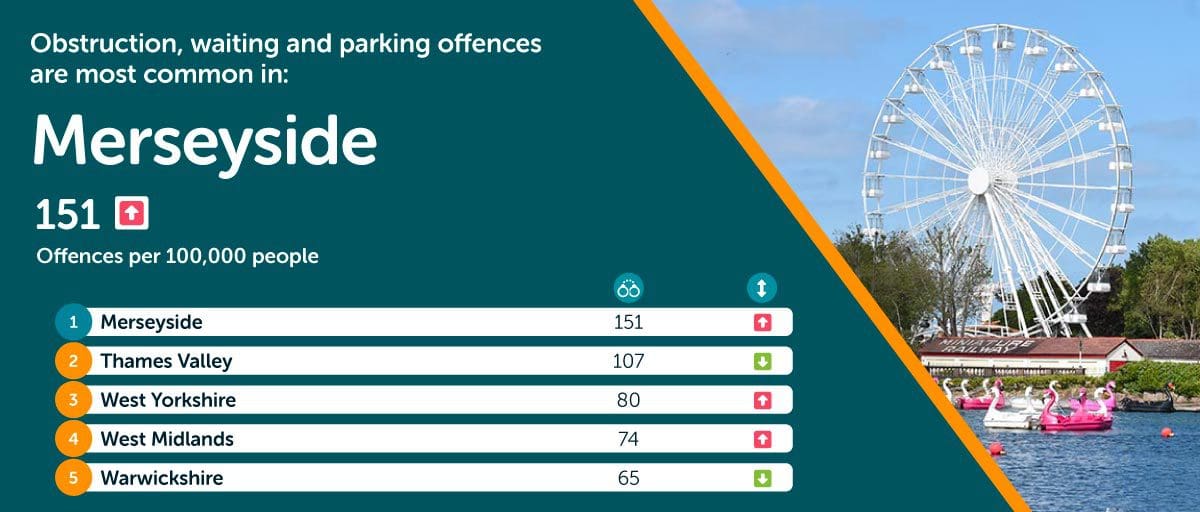
Merseyside, offences per 100,000 people: 151
Merseyside has the most obstruction, waiting and parking offences in the UK, with 151 occurrences per 100,000 people. Thames Valley came in second with 107, while every other area in the UK was below 100 offences.
Vehicle or part in dangerous or defective condition
It is important that all drivers using the road ensure that all components of their vehicles are in full working order. Not doing so can potentially put yourself and other road users at risk. Depending on the fault, you could receive a fine and three points on your licence for each faulty component, such as a bald tyre or broken headlight.
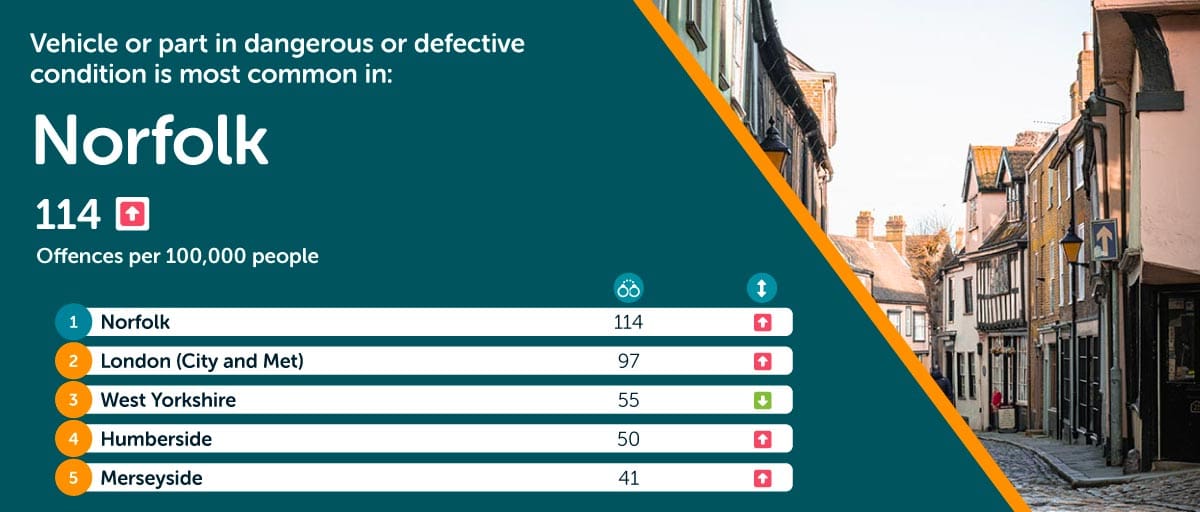
Norfolk, offences per 100,000 people: 114
Norfolk was found to have the highest rate of vehicles being in dangerous or defective condition, with 114 occurrences of this offence per 100,000 people. In 2021, the rate in Norfolk was 79 occurrences per 100,000 people.
Neglect of pedestrian rights
The most common instances of neglect of pedestrian rights are driving on pathways or blocking pedestrian crossings.
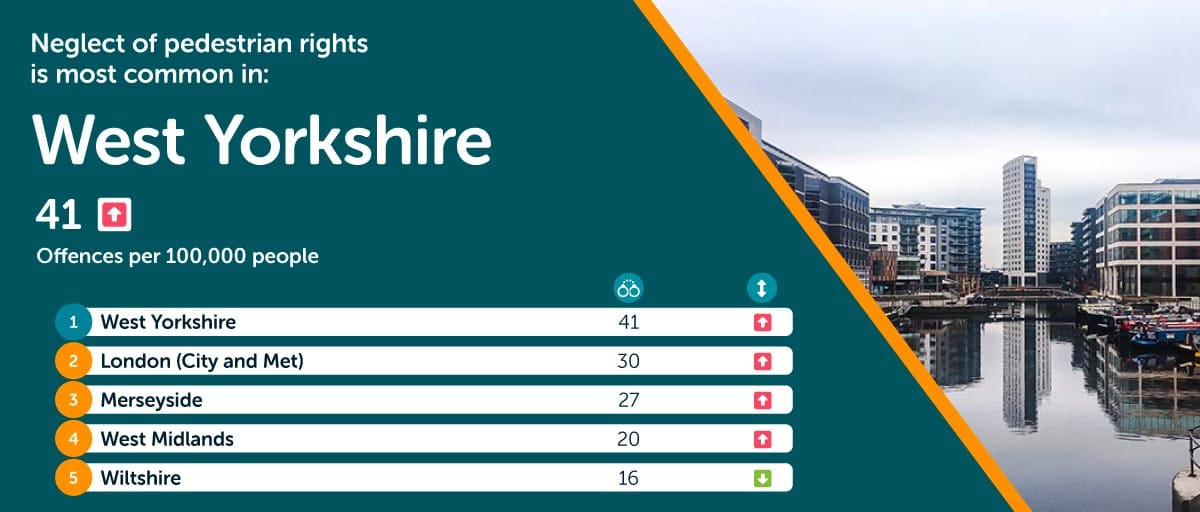
West Yorkshire, offences per 100,000 people: 41
West Yorkshire has the most neglect of pedestrian rights offences in the UK, with 41 occurrences per 100,000 people. Every other area in the UK managed to have 30 or less recorded occurrences of this offence.
Dangerous driving
Dangerous driving refers to the behaviour exhibited by a driver, that could endanger themselves or others using the road. Depending on the severity of the situation, this can result in a prison sentence of several years, a hefty fine and a driving ban.
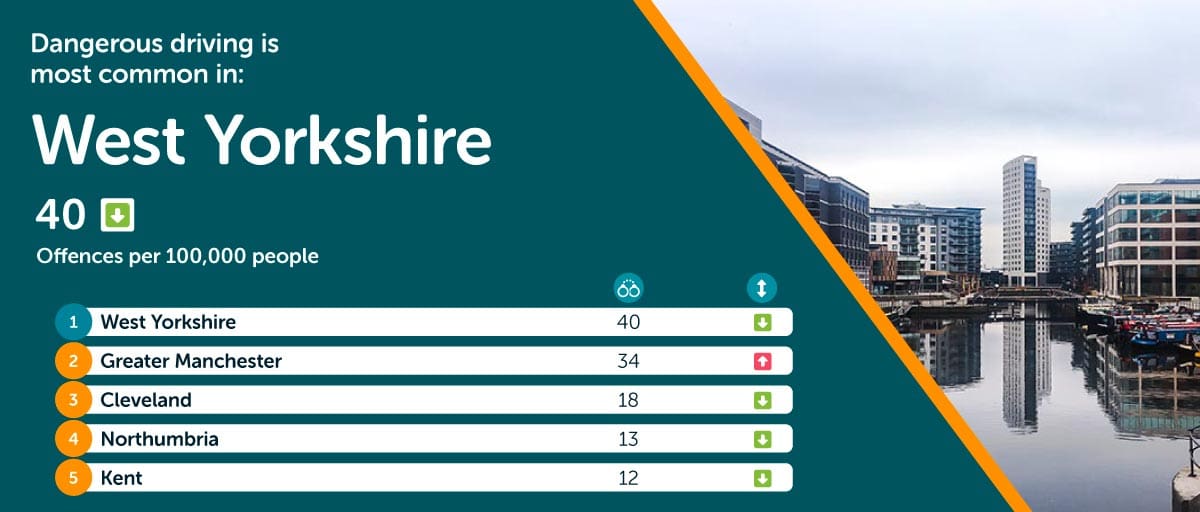
West Yorkshire, offences per 100,000 people: 40
Having recorded 40 occurrences per 100,000 people of dangerous driving offences, West Yorkshire is the biggest dangerous driving offender in the UK. In second place, Greater Manchester recorded 34 offences per 100,000, with third-placed Cleveland having half that number.
Aggravated vehicle taking
This crime differs from just car theft, as it often involves the forceful robbery of a person’s vehicle and typically injury to the owner of the vehicle. This offence can land you a two-year prison sentence.
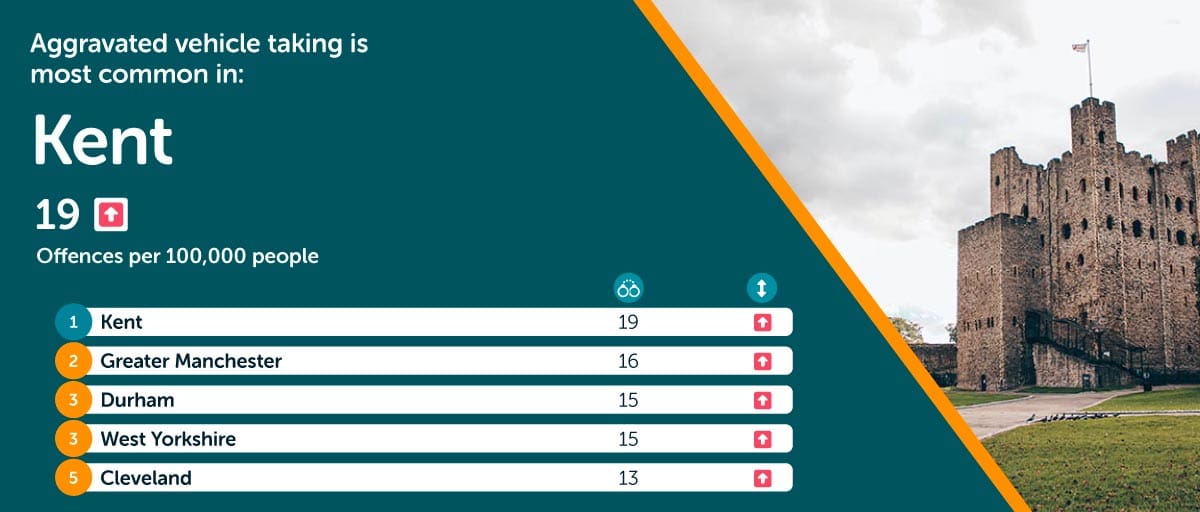
Kent, offences per 100,000 people: 19
Kent has the highest number of aggravated vehicle-taking offences in the UK, with 19 occurrences per 100,000 people. Greater Manchester took second place, with 16 offences per 100,000 people, and Durham came third with a rate of 15.
Causing death or serious injury by dangerous driving
Causing death or serious injury by dangerous driving is an extremely serious offence, and thankfully the least common car crime in the UK. If the crime was committed after the 28th of July 2022, it can result in a maximum sentence of life imprisonment, otherwise, it’s a fourteen-year prison sentence.
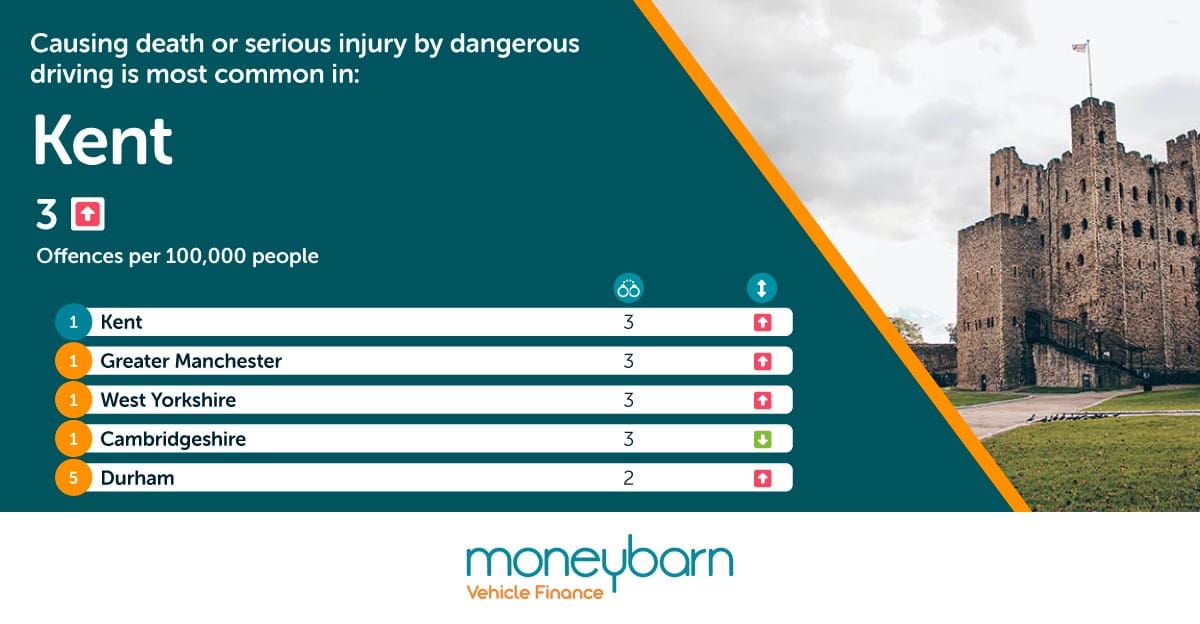
Kent, offences per 100,000 people: 3
Kent is the area with the most incidents of death or serious injury caused by dangerous driving in the UK, with a rate of 2.73 per 100,000 people. Greater Manchester came second, with a rate of 2.67 and West Yorkshire was third with 2.64.
Methodology
We’ve looked at car crime throughout the UK, identifying the most commonly committed crimes as well as where in the UK each crime is most commonly committed. To do this, we have government data to look at fixed penalty notices for motoring offences (table FPN_03) and tests (table bt_02) for the 2021 calendar year, as well as additional crime data for the 2021-22 financial year.
We then used ONS to take the population numbers for each police area, calculating the number of each car crime per 100,000 of each area’s population. For London, we combined the figures for the Metropolitan Police and the City of London Police.
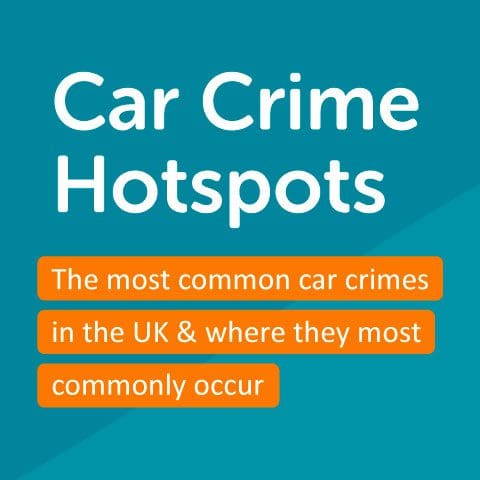
The most common car crimes in the UK & where they most commonly occur.
Owning a car, while liberating, can be stressful and sometimes costly. There’s a need for you to keep on top of your car finance payments, maintenance and repairs, the increasing costs of fuel, and adhering to the many laws of the road. If that wasn’t enough, there is also the risk that criminals may target your car.
The countless laws of the road, such as the legal obligation for your car to have seatbelts and for everyone inside the vehicle to be wearing one, are in place to better protect road users and even pedestrians. While the cost of maintaining your vehicle and keeping up with finance payments and insurance may be a financial burden to many, those things are necessary to keep you and others safe on the road.
Despite these being legal obligations, many using the roads do not observe these laws. Unfortunately, if you do adhere to the laws of the road, that doesn’t stop criminals from potentially targeting your vehicle. Whether that be damaging your car and stealing possessions within it, or even stealing the car in its entirety.
With so many laws being involved in owning a car, we’ve taken a look at a range of UK government data from 2022 to determine which car-related crimes are the most common and which areas of the UK these crimes are most commonly committed.
We have compared this to 2021 data to provide insight into how things have changed over the last couple of years.
The most common car crimes in the UK
Below, we have the most common car crimes that occur in the UK. Combining the number of occurrences for each crime by region, we have the national totals and have ranked them from most to least commonly occurring.
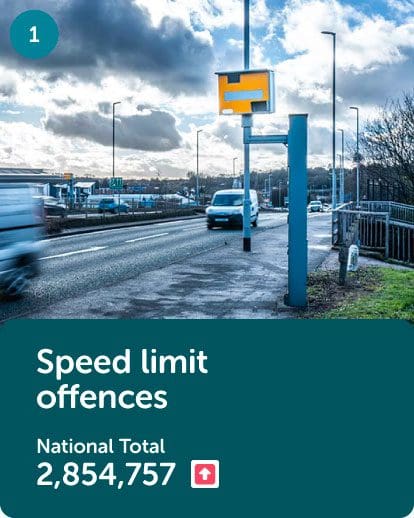
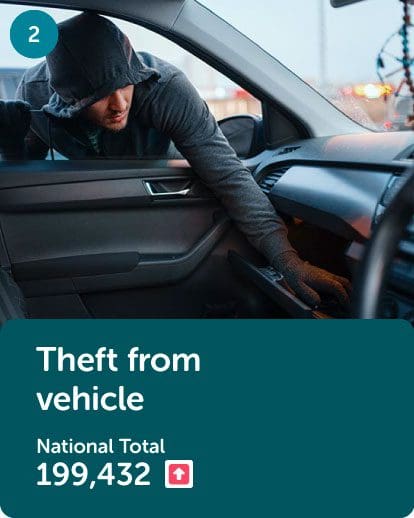
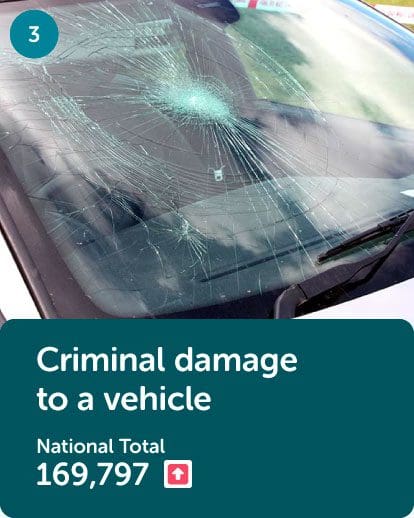
1. Speed limit offences: 2,854,757
The most common, and least surprising, car crime in the UK is speed limit offences. Recorded as the most common car crime in 2021, in 2022 the annual national total was up to more than 2.8 million. This is an increase of around one million from 2021. As ever, these speed limits should not be disregarded as they are in place to ensure everyone is travelling at a safe speed for each road in the country.
2. Theft from vehicle: 199,432
Thefts from vehicles are the second most committed car crime in the UK. For 2021-22, there were 199,432 thefts from vehicles, an increase of around 7,000 since 2021. This serves as a reminder to keep your car locked and remove any valuables so that it’s not a target for thieves.
3. Criminal damage to a vehicle: 169,797
The UK’s third most common car crime is criminal damage to a vehicle, also taking third place in 2021. The number of occurrences of this crime increased by more than 10,000 in 2022. This crime is summarised as damage consciously inflicted upon someone else’s vehicle, which can happen during a heated disagreement or even if someone hits your car with theirs and simply drives off; even if accidental, this is considered to be vandalism.

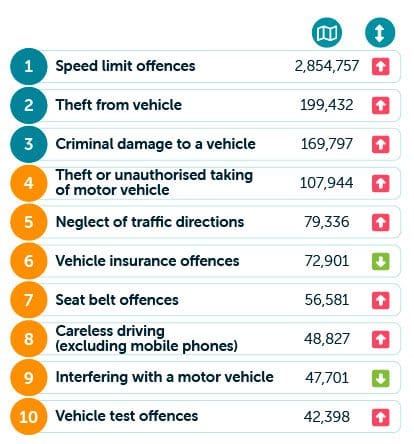
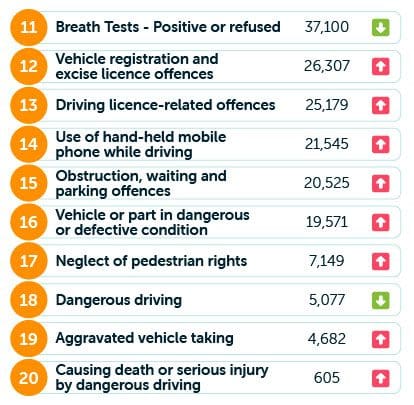
The parts of the country where each car crime is most common
With the most common car crimes in the country revealed, we now look at the car crime hotspots in the UK.

Speed limit offences
We have already established that speed limit laws are in place to better protect users of the road and pedestrians too. These speed limits are in place to ensure that everyone travels at a safe speed to reduce the risk of road collisions involving other drivers, or pedestrians.

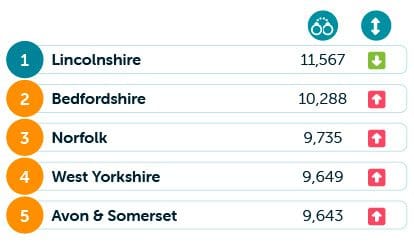
Lincolnshire, offences per 100,000 people: 11,567
Lincolnshire is the UK’s speeding hotspot, with 11,567 instances of speeding offences, per 100,000 people in 2022. This is a 14% decrease since 2021, which was 13,420 per 100,000 people, but still lands the city in the top spot.
Theft from vehicle
Anyone can find themselves a victim of this crime, that’s why it’s best to keep your car locked at all times, with any valuables removed, and if possible in a well-lit place with CCTV.
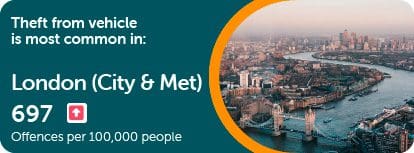
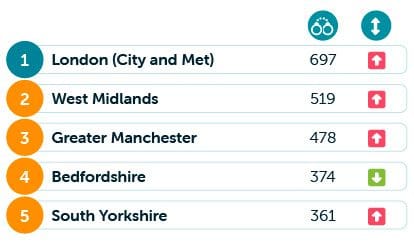
London (City & Met), offences per 100,000 people: 697
London has the most theft from vehicle offences in the UK, with 697 per 100,000 people, a marginally higher rate than the 688 per 100,000 people in 2021. The West Midlands takes second place, with the region having 519 offences per 100,000 people, a sharp rise from 208 per 100,000 in 2021.
Criminal damage to a vehicle
One of the most frustrating car crimes is being targeted by someone who deliberately damages your vehicle for seemingly no good reason.

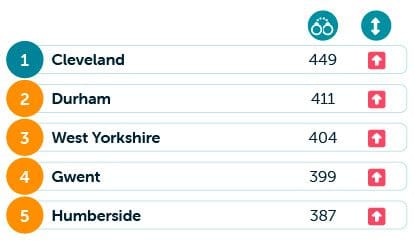
Cleveland, offences per 100,000 people: 449
Taking the top spot is the historic county of Cleveland, located in the North East of England, with the highest rates of criminal damage to vehicles. They recorded 449 offences per 100,000 people, which is a slight increase from 2021’s 430 per 100,000 people.
Theft or unauthorised taking of a motor vehicle
Just as having your car damaged can be a stressful experience, having your entire vehicle stolen can leave the owner of the car distraught and deeply inconvenienced. While insurance may cover this crime, this does not lessen the emotional and financial impact it can have.

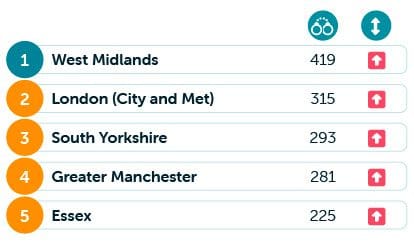
West Midlands, offences per 100,000 people: 419
West Midlands comes out as the area with the most car theft offences in the UK, with 419 per 100,000 people. In 2021, London placed first with 278 car thefts per 100,000, so this is quite the increase.
Neglect of traffic directions
Traffic directions can take many forms, from road signs to traffic lights, and should not be taken lightly or ignored. They are in place to ensure that traffic runs smoothly and to also guide pedestrians as they navigate crossings. Neglecting these directions can put you, other road users and pedestrians in severe danger.

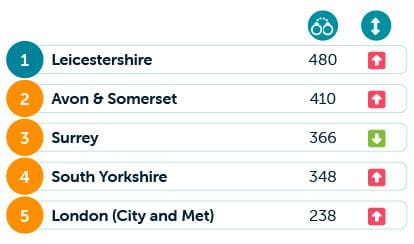
Leicestershire, offences per 100,000 people: 480
Leicestershire has the most neglect of traffic directions offences, registering 480 instances of this particular offence, per 100,000 people. In 2021, Surrey had the most offences of this kind, with 416.
Vehicle insurance offences
All vehicles on the road are legally required to have insurance, this serves to protect yourself and other road users in the event of an accident. Driving without any insurance will result in a £300 fine and up to six points on your licence. Though in the event this goes to court, you could get an unlimited fine and be disqualified from driving.
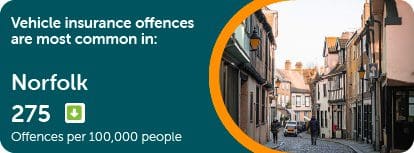
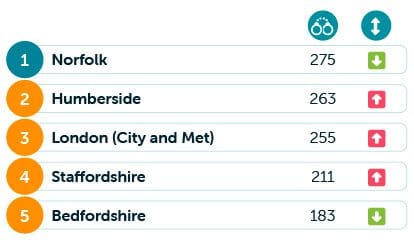
Norfolk, offences per 100,000 people: 275
With 275 vehicle insurance offences per 100,000 people, Norfolk takes the number one spot. However, the number of offences has decreased somewhat, as previously Norfolk recorded 292 offences per 100,000 people in 2021.
Seat belt offences
Seat belts have been a legal requirement since 1983 in the UK and have undoubtedly been responsible for saving countless lives. Despite this, it is the seventh most common car crime in the UK. If you are caught not wearing a seatbelt when you should be, you could face a fine of up to £500.

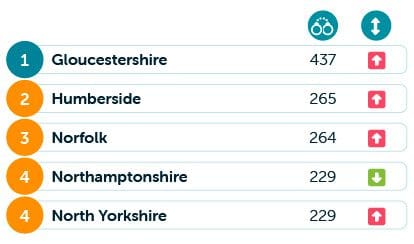
Gloucestershire, offences per 100,000 people: 437
Gloucestershire registered 437 seat belt offences per 100,000 people in 2022, making it the most offending area in the UK for this specific crime! In second place, Humberside also registered 265 per 100,000 people. The top six ranking areas in the UK for this offence all registered more than 200 offences per 100,000.
Careless driving (excluding mobile phones)
This is when the person in charge of a vehicle does so without the proper care and attention required. This can endanger other road users, the fixed penalty for this offence is a £100 fine and three points on your licence.


Essex, offences per 100,000 people: 275
Essex by far has the most careless driving offences (where mobile phones are not concerned) with 275 per 100,000 people in 2022. Every other area in the UK managed below 200.
Interfering with a motor vehicle
Interfering with a motor vehicle refers to someone tampering with a car, internal and external car parts, or the contents of a car. This offence can result in a prison sentence of up to three months.

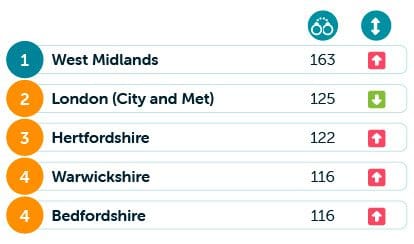
West Midlands, offences per 100,000 people: 163
The West Midlands recorded 163 instances of this crime per 100,000 people, making it the number one offender of this crime. There is quite a gap between second-placed London, who recorded just 125 per 100,000 people.
MOT offences
With the use of your vehicle comes the inevitable wear and tear of its components, leading to faults that can potentially put yourself and other road users at risk. However, this is where MOT tests come in, as every vehicle is required to have one annually, to make sure your vehicle is road safe. Driving without having passed an MOT test is an offence.
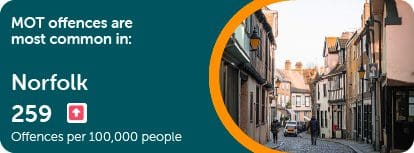

Norfolk, offences per 100,000 people: 259
Norfolk takes first place for the most MOT offences per 100,000 people in the UK, with 259, an increase of around 100 compared to 2021’s numbers. In second place was Humberside with 202, which is also quite a gap.
Breath Tests - Positive or refused
Driving under the influence of substances such as drugs and alcohol is against the law, as it is extremely dangerous and can put road users at serious risk. Breath tests are the main way of catching culprits, a positive test or refusal of the test being indicative of a crime being committed.

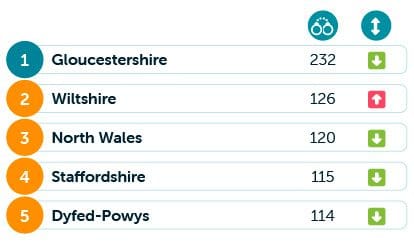
Gloucestershire, offences per 100,000 people: 232
With 232 instances per 100,000 people of breath tests coming back positive or refused, Gloucestershire is the number one offender of this particular crime. In 2021, Gloucestershire also ranked first, however, their figure was much higher at 303 per 100,000.
Vehicle registration and excise licence offences
Vehicles driven on public roads must be registered and taxed. Road tax helps to pay for the upkeep and maintenance of the UK’s road network, making them safer to use.

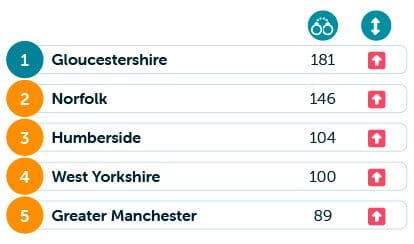
Gloucestershire, offences per 100,000 people: 181
Gloucestershire once again tops the rankings, this time for vehicle registration and excise licence offences, with 181 occurrences of this offence per 100,000 people. Only Norfolk and Humberside, alongside Gloucestershire, managed more than 100 occurrences of this offence in the UK per 100,000 people.
Driving licence-related offences
Every driver in the UK is legally required to have a driver’s licence, this serves as proof that you are a competent driver who can observe all the laws of the road. Learners can drive using a provisional driving licence, but only so long as they are accompanied by another individual who has had their full driving licence for several years. Driving without a licence is a severe offence, and if caught, can get you up to six penalty points and a fine of up to £5,000.
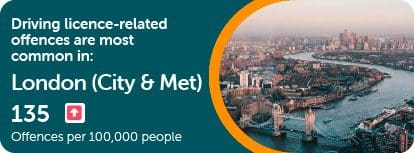
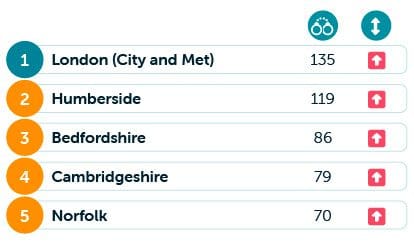
London, offences per 100,000 people: 135
England’s capital city has the highest rate of driving licence-related offences in the UK, with 135 per 100,000 people. Narrowly in second place, we have Humberside, with 119, making these two areas the only ones in the UK with more than 100 offences for this crime per 100,000 people.
Use of hand-held mobile phone while driving
Using a hand-held mobile phone whilst driving can distract the driver’s attention from the road, potentially putting other road users at risk of serious injury or worse. As such, it is illegal to do so in the UK and can result in six points on your licence and a £200 fine. If you passed your driving test within two years of being caught doing so, your licence can be revoked.
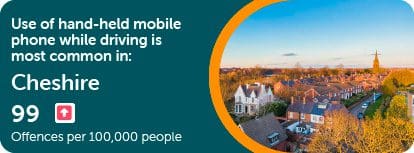
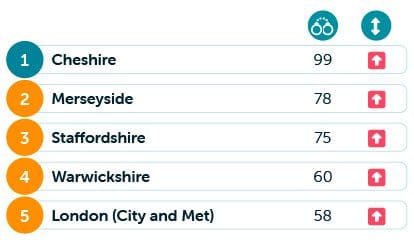
Cheshire, offences per 100,000 people: 99
With 99 occurrences per 100,000 of the area’s population, Cheshire has the highest rate of people being caught using hand-held mobile phones while driving. Every area in the UK had below 100 occurrences of this offence per 100,000 people.
Obstruction, waiting and parking offences
It is illegal to park your car in certain places as this can obstruct traffic and pedestrians, as well as block access to sites. Parts of the road where parking is not permitted should be clearly marked, this is typically done with the use of double yellow lines. It is also an offence to mount the curb with your vehicle and block a walkway.

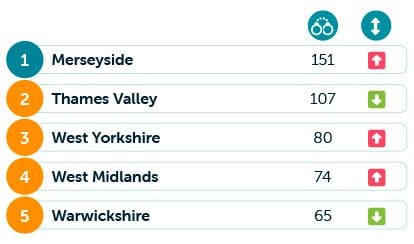
Merseyside, offences per 100,000 people: 151
Merseyside has the most obstruction, waiting and parking offences in the UK, with 151 occurrences per 100,000 people. Thames Valley came in second with 107, while every other area in the UK was below 100 offences.
Vehicle or part in dangerous or defective condition
It is important that all drivers using the road ensure that all components of their vehicles are in full working order. Not doing so can potentially put yourself and other road users at risk. Depending on the fault, you could receive a fine and three points on your licence for each faulty component, such as a bald tyre or broken headlight.
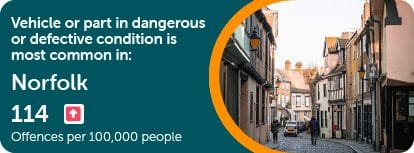
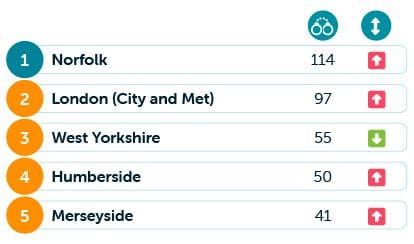
Norfolk, offences per 100,000 people: 114
Norfolk was found to have the highest rate of vehicles being in dangerous or defective condition, with 114 occurrences of this offence per 100,000 people. In 2021, the rate in Norfolk was 79 occurrences per 100,000 people.
Neglect of pedestrian rights
The most common instances of neglect of pedestrian rights are driving on pathways or blocking pedestrian crossings.
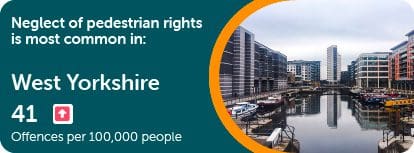
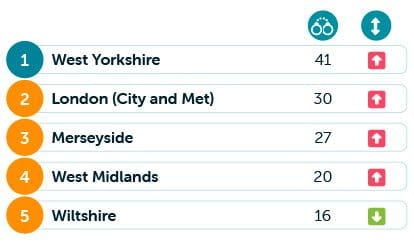
West Yorkshire, offences per 100,000 people: 41
West Yorkshire has the most neglect of pedestrian rights offences in the UK, with 41 occurrences per 100,000 people. Every other area in the UK managed to have 30 or less recorded occurrences of this offence.
Dangerous driving
Dangerous driving refers to the behaviour exhibited by a driver, that could endanger themselves or others using the road. Depending on the severity of the situation, this can result in a prison sentence of several years, a hefty fine and a driving ban.
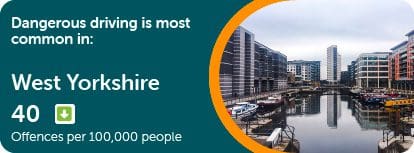
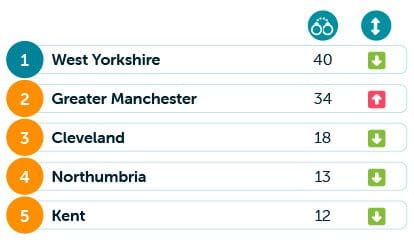
West Yorkshire, offences per 100,000 people: 40
Having recorded 40 occurrences per 100,000 people of dangerous driving offences, West Yorkshire is the biggest dangerous driving offender in the UK. In second place, Greater Manchester recorded 34 offences per 100,000, with third-placed Cleveland having half that number.
Aggravated vehicle taking
This crime differs from just car theft, as it often involves the forceful robbery of a person’s vehicle and typically injury to the owner of the vehicle. This offence can land you a two-year prison sentence.
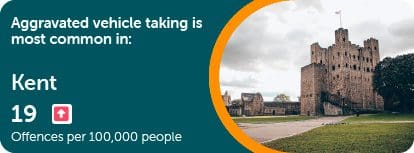
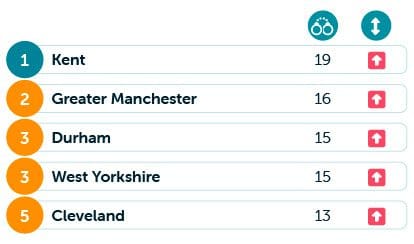
Kent, offences per 100,000 people: 19
Kent has the highest number of aggravated vehicle-taking offences in the UK, with 19 occurrences per 100,000 people. Greater Manchester took second place, with 16 offences per 100,000 people, and Durham came third with a rate of 15.
Causing death or serious injury by dangerous driving
Causing death or serious injury by dangerous driving is an extremely serious offence, and thankfully the least common car crime in the UK. If the crime was committed after the 28th of July 2022, it can result in a maximum sentence of life imprisonment, otherwise, it’s a fourteen-year prison sentence.
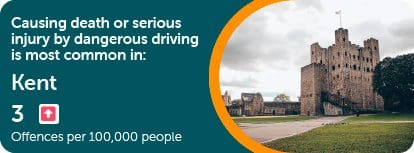
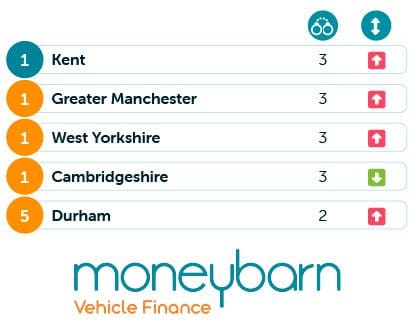
Kent, offences per 100,000 people: 3
Kent is the area with the most incidents of death or serious injury caused by dangerous driving in the UK, with a rate of 2.73 per 100,000 people. Greater Manchester came second, with a rate of 2.67 and West Yorkshire was third with 2.64.
Methodology
We’ve looked at car crime throughout the UK, identifying the most commonly committed crimes as well as where in the UK each crime is most commonly committed. To do this, we have government data to look at fixed penalty notices for motoring offences (table FPN_03) and tests (table bt_02) for the 2021 calendar year, as well as additional crime data for the 2021-22 financial year.
We then used ONS to take the population numbers for each police area, calculating the number of each car crime per 100,000 of each area’s population. For London, we combined the figures for the Metropolitan Police and the City of London Police.
Bringing you the latest news and insights from Moneybarn.
More from Moneybarn...
For a better road ahead
Moneybarn is a member of the Finance and Leasing Association, the official trade organisation of the motor finance industry. The FLA promotes best practice in the motor finance industry for lending and leasing to consumers and businesses.
Moneybarn is the trading style of Moneybarn No. 1 Limited, a company registered in England and Wales with company number 04496573, and Moneybarn Limited, a company registered in England and Wales with company number 02766324. The registered address for these companies is: Athena House, Bedford Road, Petersfield, Hampshire, GU32 3LJ.
Moneybarn’s VAT registration number is 180 5559 52.
Moneybarn Limited is authorised and regulated by the Financial Conduct Authority (Financial Services reference No. 702781)
Moneybarn No. 1 Limited is authorised and regulated by the Financial Conduct Authority (Financial Services reference No. 702780)




